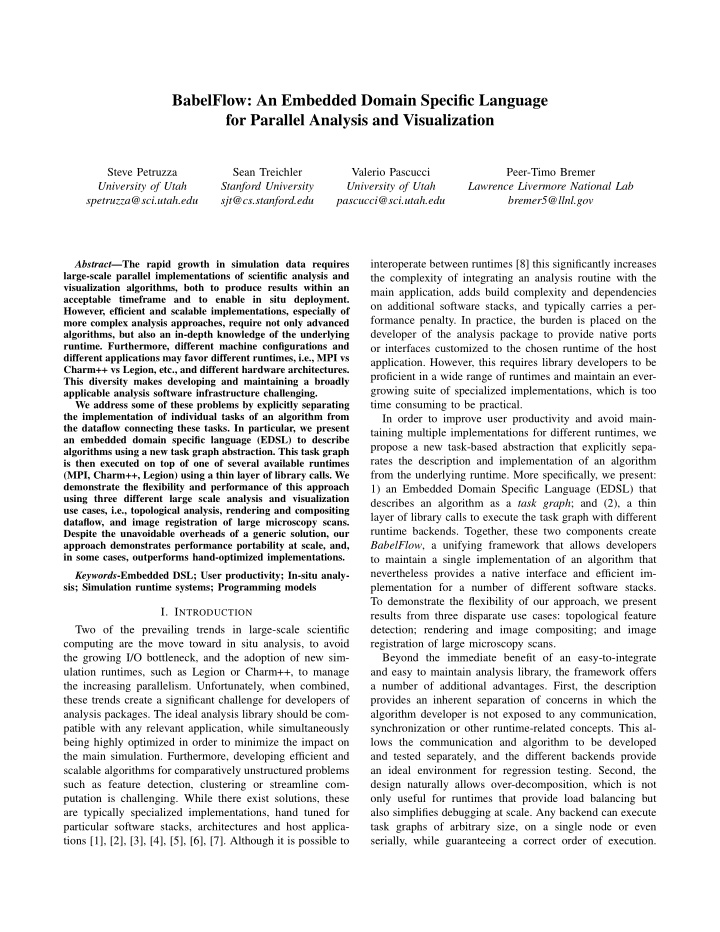



BabelFlow: An Embedded Domain Specific Language for Parallel Analysis and Visualization Steve Petruzza Sean Treichler Valerio Pascucci Peer-Timo Bremer University of Utah Stanford University University of Utah Lawrence Livermore National Lab spetruzza@sci.utah.edu sjt@cs.stanford.edu pascucci@sci.utah.edu bremer5@llnl.gov interoperate between runtimes [8] this significantly increases Abstract —The rapid growth in simulation data requires large-scale parallel implementations of scientific analysis and the complexity of integrating an analysis routine with the visualization algorithms, both to produce results within an main application, adds build complexity and dependencies acceptable timeframe and to enable in situ deployment. on additional software stacks, and typically carries a per- However, efficient and scalable implementations, especially of formance penalty. In practice, the burden is placed on the more complex analysis approaches, require not only advanced algorithms, but also an in-depth knowledge of the underlying developer of the analysis package to provide native ports runtime. Furthermore, different machine configurations and or interfaces customized to the chosen runtime of the host different applications may favor different runtimes, i.e., MPI vs application. However, this requires library developers to be Charm++ vs Legion, etc., and different hardware architectures. proficient in a wide range of runtimes and maintain an ever- This diversity makes developing and maintaining a broadly growing suite of specialized implementations, which is too applicable analysis software infrastructure challenging. We address some of these problems by explicitly separating time consuming to be practical. the implementation of individual tasks of an algorithm from In order to improve user productivity and avoid main- the dataflow connecting these tasks. In particular, we present taining multiple implementations for different runtimes, we an embedded domain specific language (EDSL) to describe propose a new task-based abstraction that explicitly sepa- algorithms using a new task graph abstraction. This task graph rates the description and implementation of an algorithm is then executed on top of one of several available runtimes from the underlying runtime. More specifically, we present: (MPI, Charm++, Legion) using a thin layer of library calls. We demonstrate the flexibility and performance of this approach 1) an Embedded Domain Specific Language (EDSL) that using three different large scale analysis and visualization describes an algorithm as a task graph ; and (2), a thin use cases, i.e., topological analysis, rendering and compositing layer of library calls to execute the task graph with different dataflow, and image registration of large microscopy scans. runtime backends. Together, these two components create Despite the unavoidable overheads of a generic solution, our BabelFlow , a unifying framework that allows developers approach demonstrates performance portability at scale, and, in some cases, outperforms hand-optimized implementations. to maintain a single implementation of an algorithm that nevertheless provides a native interface and efficient im- Keywords -Embedded DSL; User productivity; In-situ analy- sis; Simulation runtime systems; Programming models plementation for a number of different software stacks. To demonstrate the flexibility of our approach, we present I. I NTRODUCTION results from three disparate use cases: topological feature Two of the prevailing trends in large-scale scientific detection; rendering and image compositing; and image computing are the move toward in situ analysis, to avoid registration of large microscopy scans. the growing I/O bottleneck, and the adoption of new sim- Beyond the immediate benefit of an easy-to-integrate ulation runtimes, such as Legion or Charm++, to manage and easy to maintain analysis library, the framework offers the increasing parallelism. Unfortunately, when combined, a number of additional advantages. First, the description these trends create a significant challenge for developers of provides an inherent separation of concerns in which the analysis packages. The ideal analysis library should be com- algorithm developer is not exposed to any communication, patible with any relevant application, while simultaneously synchronization or other runtime-related concepts. This al- being highly optimized in order to minimize the impact on lows the communication and algorithm to be developed the main simulation. Furthermore, developing efficient and and tested separately, and the different backends provide scalable algorithms for comparatively unstructured problems an ideal environment for regression testing. Second, the such as feature detection, clustering or streamline com- design naturally allows over-decomposition, which is not putation is challenging. While there exist solutions, these only useful for runtimes that provide load balancing but are typically specialized implementations, hand tuned for also simplifies debugging at scale. Any backend can execute particular software stacks, architectures and host applica- task graphs of arbitrary size, on a single node or even tions [1], [2], [3], [4], [5], [6], [7]. Although it is possible to serially, while guaranteeing a correct order of execution.
Recommend
More recommend